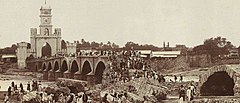 Refugees walk across a bridge with the Afzal Darwaza in the background, during the Great Musi Flood of 1908 | |
| Date | 28 September 1908 – 29 September 1908 |
|---|---|
| Location | Hyderabad, Hyderabad State, British India (now in Telangana, India) |
| Deaths | >15,000 |
| Property damage | £1,250,000 (over £104 million in 2021) |

The Great Musi Flood was a devastating flood that occurred on 28 September 1908 in Hyderabad on the banks of the Musi River.[1] The city of Hyderabad was the capital of the Hyderabad State, ruled by the Nizam, Mir Mahbub Ali Khan.[2]
The flood, locally known as Thughyani Sitambar, shattered the life of the people living in Hyderabad, killing 50,000 people [3][4] It washed away three bridges — the Afzal, Mussallam Jung and Chaderghat, such that the Puranapul became the only link between the two parts of the city.[5]
- ^ Law 1914, pp. 85–92.
- ^ Chisholm, Hugh, ed. (1911). . Encyclopædia Britannica. Vol. 14 (11th ed.). Cambridge University Press.
- ^ "Los Angeles Herald 3 October 1908 — California Digital Newspaper Collection". Cdnc.ucr.edu. Retrieved 2 January 2019.
- ^ "Archived copy". Archived from the original on 18 May 2015. Retrieved 10 May 2015.
{{cite web}}: CS1 maint: archived copy as title (link) - ^ Ifthekhar, J. S. (11 July 2013). "Musing over the Musi". Thehindu.com. Retrieved 2 January 2019.